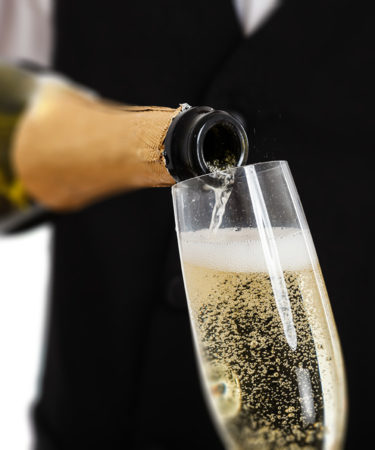Before we get to the technical stuff, the first lesson of pouring Champagne, of course: pour with swag. And possibly a velvet serving towel on your arm. OK, we got that down. Now, assuming you know how to saber a bottle of Champagne (a party must), let’s move on to the pouring itself: how do you pour Champagne so you can avoid all that foam at the top?
Not that you’d necessarily want to. Some people like the foaming up—it looks opulent, excessive, kind of like one medium-sized yacht party towing another, larger yacht party. But the fact is, just like opening a bottle of Champagne incorrectly (the pop-and-fly celebratory style), you may lose some of the good stuff if you let it foam up too much. Not to mention that annoying wait time between pouring and drinking. (Ten seconds never felt so long.)
But pouring Champagne is actually a little trickier than you’d think. There are rules, some of them conflicting. Adorably chic French author Mireille Guiliano insists the proper way to pour Champagne is halfway. (Her reasoning is solid, and we may adapt it: Champagne is to be sipped, and if you pour more than halfway up the glass, chances are you won’t drink enough of it before the Champagne warms. “And warm Champagne? Not too great.”)
Leaving levels aside, what about the basic pouring method? How do we keep the foam monster at bay? It’s actually a little more difficult than you’d think, as there are two basic theories on how to pour Champagne. In both cases, you hold the bottle itself by the punt—that divet in the bottom of the bottle. Insert your thumb into the punt (imagine you’re about to go bowling with Champagne bottles) and splay your other four fingers on the bottle to hold it. You can also use a couple fingers to support the top of the neck of the bottle as you pour. (Alternately, you can also just hold the bottle with your hands, feet, pulley system, however you so please.)
Onto the pouring itself. The traditional method says you leave the glass totally straight and level on the table and pour directly into it from above. But here’s a key for getting a foam-free (or less foamy) pour: you don’t pour all at once: you “wet” the glass with just a splash of Champagne, allowing the bubbles to settle. Then you finish pouring, again directly into the glass at a 90 degree angle, but only between 2/3 and ¾ of the way full. The second method is basically the same, except it employs the classic beer-glass-tilt.
So which way to go, tilted or straight up? We’re going to go with tilted. And here’s why: Guiliano tilts the glass in her video, and considering how on-point her outfit is, it’s hard to argue with just about anything she does. But there’s also a study published by some French scientists themselves that supports the tilt. In 2010, French scientists at the University of Reims “examined how the two methods of pouring affected the release oaf CO2 and tested bottles chilled to varying degrees.” Apparently “Champagne poured like beer retained more gas”—meaning fewer bubbles foaming up at the top of the glass. The more traditional straight-down angle was said to be intended to “create a head of ‘mousse,’ or foam.”
Perhaps last, and most important, to note, “the colder the bottle, the less gas was lost.” Meaning if your Champagne is over temperature, it’s going to be hard to avoid foam no matter how deftly you pour. Chilled Champagne jealously guards its bubbles. (Also good to remember, there’ll always be a little bit of foam, but ideally not enough to top a latte.)
So what have we learned, Dorothy? Wet the glass. Tilt the glass slightly, as you would a beer glass. And make sure that bubbly is cold. Also, if desired, invite some friends to enjoy the bottle with you. Or not…(‘Cuz, you know. Champagne.)
